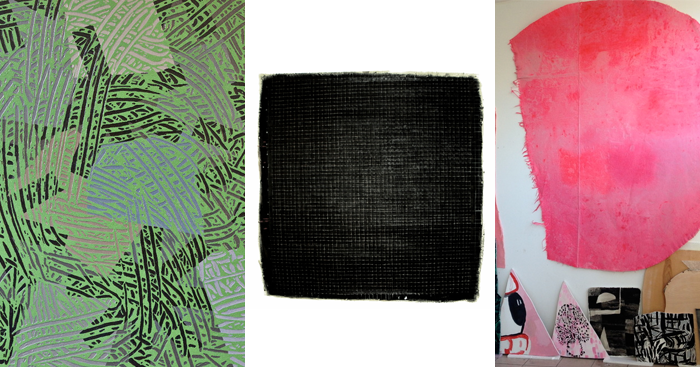
Legends for Loose Grids
Waiting Room presents work by 3 artists David Bartley (Minneapolis), Alexander Herzog (Milwaukee) and Leslie Baum (Chicago)
Legends for Loose Grids is a relaxed triangulation of artists and ideas, bringing together the work of David Bartley, Leslie Baum, and Alexander Herzog. Together, their studio practices are networked by a shared interest in painting as a process, and format, as well as a concision device for personal vocabularies, grid systems, and modernist art histories.
The grid has long been a logical way to discuss the materiality of painting. Roselind Krauss describes the grid as, “a structure emblematic of the modernist ambition…” she says, “Indeed, if it maps anything, it maps the surface of the painting itself.” Within the exhibition, the artists approach the grid directly, as a framework to operate in and a structure to unbind; as Cartesian space in which to situate relationships; and implicitly, in the methodical labor of production - the repetitive, accumulative, patterned action of the artists hand - or in the cotton weave of the canvas substrates.
In the work, we see warps and wefts of art history; each artist offers a series of chess moves through a chronology of painters, nodding to Caravaggio, cropping Guston, grafting Martin, an offering for Frankenthaler, an ode to Cezanne, an accidental Twombly. Here grids are elastic, and can stretch over space and time, like 3-D checkers. These grids are non-silent, serving as an efficient container for artistic labor and personal and art-historical narratives.
About the Artists
Leslie Baum shares a sampling of new work from her alphabet-like clusters of paintings-cum-installations. Her paintings parade out into exhibition space like scenic design, occupying a bivalence of foreground/background and in-frame/beyond-frame.
David Bartley shares large-scale patterned works evidencing the labor of obsessive patterning, and residual build up, of personal and art-historical histories.
Alexander Herzog’s surfaces are worked with gesso, leaving the corporal traces of the artists hand. The artist likens the methodical practice of building and leveling the surface of his work to the mundane or repetitive activities of the hospitality industry, like washing and cooking.
Find out what's up every week.
No spam. Just local art news and events straight to your inbox.